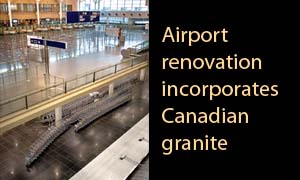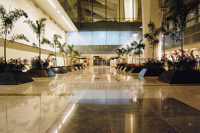
Montreal-Pierre Elliott Trudeau International Airport's new International Arrivals Terminal, comprising an expansive Canada Customs hall and a high-capacity baggage claim room, is the showpiece of the “new†Montreal-Trudeau Airport, and another milestone in completion of the airport terminal's expansion and modernization program. This portion of construction featured Laurentian Green and Stanstead Grey granite quarried by Polycor Inc. of Saint-Sebastien, Quebec, Canada.
“This new international arrivals complex is the gateway to Canada for all passengers arriving from the U.S. and internationally,†said James Cherry, President and Chief Executive Officer of Aeroports de Montreal. “We want to give these passengers -- those visiting our country and those arriving home after a trip abroad -- a welcome worthy of greater Montreal. That's the reason for the impressive architecture of the new Canada Customs hall, featuring an approximate 36-foot-high cathedral ceiling, three skylights fitted with sails, and a 'floating' floor covered in Quebec granite.†The fact that the granite was quarried in Quebec played a key factor in why the material was chosen for the project.
“There was a strong desire in our concept to reflect local identity in our airport's new image,†said Michel Hardy of Consortium PCJA, the design architect for the project. “There is a lot of nice granite in our area. Limestone was largely used in the past for our public buildings [for walls]; granite was used for flooring and also in the older sections of the Montreal Airport for pavement. Stanstead granite was especially used for pavement on the old streets. The material remained available over time. It is a long-term solution which is also good for sustainable development.â€
Additionally, the fact that granite is a natural product also gives it a sense of neutrality as far as historic reference is concerned, according to Hardy. “The use of granite in [a] standard dimension makes it look like 'today's' material,†he said. “In that sense, granite bridged the past with today's need in public transportation. It is a noble material.â€
The Customs area features 8- x 24-inch tiles of the granite in both honed and polished finishes. The honed tiles are used as accent pieces. Companie Carrelage de Montreal was responsible for the installation and supply of architectural finishes. “We supplied and installed 160,000 square feet,†said Andre Giguere, project director. He supervised and coordinated all activities related to the job.
“The neutral, light color of the Stanstead Grey is in line with the architectural language of the building renovations -- sober whites and grays within a “high-tech†look,†said Karen McAuley, an architect with Consortium PCJA. “The Laurentian Green also fits into this line of thought -- an appearance of dark gray with a touch of green.
“Granite was chosen in continuity with the rest of the airport renovations,†continued McAuley. “Granite's long-term durability as well as its unequivocal aesthetic properties and ease of maintenance were the reasons for the original choice.â€
Agreeing with McAuley, Jean St. Onge of Polycor said that the consistency of the granite and its neutral color significantly influenced the materials selection. “The Laurentian Green was chosen because of its unique green due to the presence of blue quartz in its structure,†he said. “There is also an interesting contrast between the polished and the honed finish, which was a design choice made by PCJA.â€
The new complex expands by several times the handling capacity for arriving international and trans-border flights. The new Canada Customs hall includes 26 inspection stations located in a single line and three CANPASS
Air automated self-service kiosks, compared with 16 stations positioned in the traditional staggered pattern in the old hall. The physical capacity of the new baggage carrousels is double that of the old facilities, the area of the room has been tripled and the peak-period handling capacity is four times greater.
The new International Arrivals complex is the second major component of the “new†Montreal-Trudeau Airport to open for business, after the trans-border jetty that went into operation in April 2003.
The opening of the new international jetty in June 2005, in time for the Formula One Grand Prix of Canada and the tourism high season, will complete the main elements of Montreal-Trudeau's refurbished terminal. In addition, several improvements to the old part of the terminal will be completed by late 2005, including an expanded and improved public arrivals hall.
All involved are very pleased with the outcome of the Customs Hall. According to Giguere, the owner was very satisfied, and has plans to install more granite in the future extension of the airport. “The results are outstanding,†said St. Onge. “It really shows the result of a nice-looking stone and finishes with great architectural work.â€

End box
Montreal-Pierre Elliott Trudeau International AirportInternational Arrivals Complex
Montreal, Canada
Architectural joint venture team: PCJA Architects (Provencher Roy, Cardinal et Hardy, Jodoin Lamarre Pratte, ARCOP)
Construction: Michel Desrosiers, Allan Thomas
Site Supervision: Michel Bourassa
Stone Installer: Companie Carrelage de Montreal
Stone Quarrier: Polycor Inc., Saint-Sebastien, Quebec, Canada



